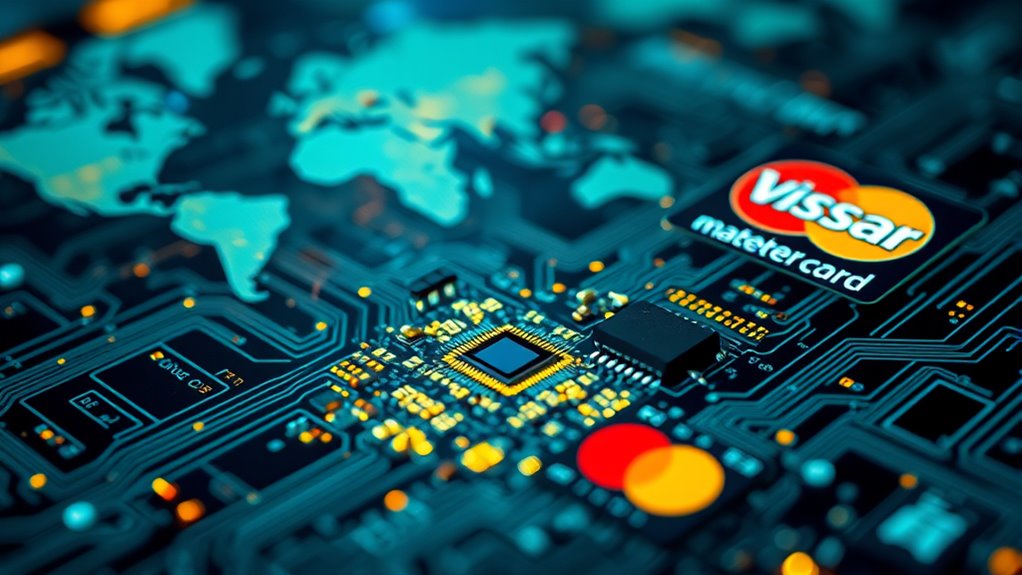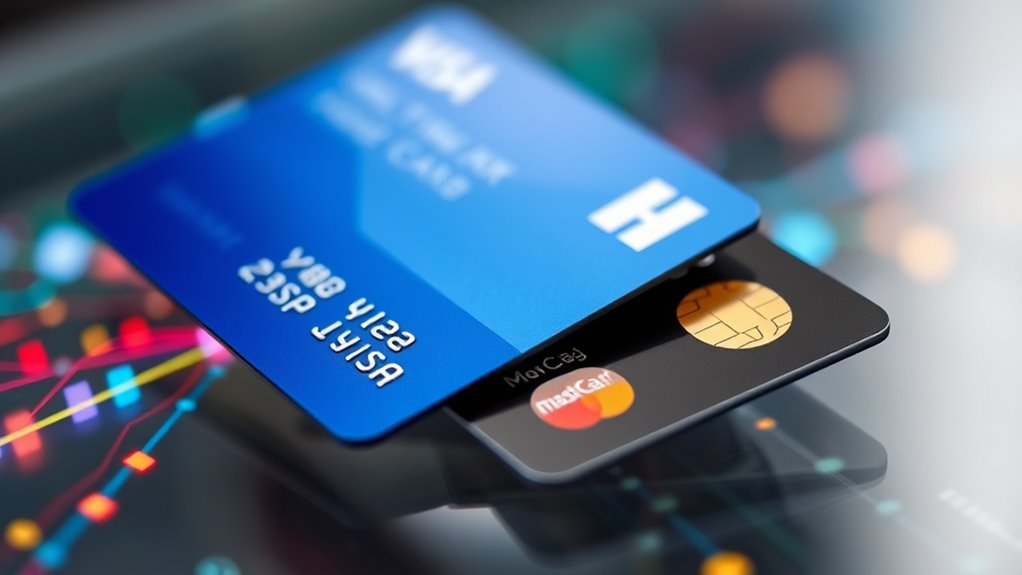When you make a purchase with your card, Visa or Mastercard quickly route your transaction details from the merchant to your bank for approval. They check for funds and fraud, then send a response back. If approved, they handle the clearing and settlement to transfer money from your bank to the merchant’s account. These networks act as secure conduits, making the process smooth. Keep exploring to discover more about how they keep your transactions safe and reliable.
Key Takeaways
- Visa and Mastercard act as intermediaries routing transaction data between merchants, issuing banks, and acquiring banks.
- They do not hold customer funds but facilitate authorization, clearing, and settlement processes.
- When a purchase is made, they send authorization requests to the cardholder’s bank for approval.
- They exchange detailed transaction data during clearing, ensuring accurate record-keeping.
- Ultimately, they guarantee fund transfers between banks, enabling seamless and secure payments.

Card networks like Visa and Mastercard serve as indispensable intermediaries in electronic transactions, connecting merchants, cardholders, and banks to guarantee smooth payments. When you swipe, tap, or enter your card details online, these networks step into action behind the scenes. They don’t issue cards themselves but play a pivotal role in routing your transaction requests to the right banks and ensuring funds move correctly. Their primary job is to act as a bridge between your bank (the issuer) and the merchant’s bank (the acquiring bank), making sure your payment gets authorized, cleared, and settled efficiently. They operate within complex regulatory frameworks to ensure compliance and security. Once you initiate a payment, your card network receives the authorization request from the merchant’s payment terminal or gateway. They then route this request to your issuing bank to verify your card details and check if you have enough credit or funds available. The issuer performs quick fraud checks, including AVS and CVV validation, and responds with an approval or decline almost instantly. If approved, the network sends the response back to the merchant, who can then proceed with completing your purchase. If declined, the merchant is notified immediately, and the transaction doesn’t go through. During the authorization stage, your bank confirms your card’s validity and available credit, placing a temporary hold on the amount. This hold ensures that funds are reserved for the purchase but aren’t yet transferred. If the transaction is declined, it could be due to insufficient funds, expired cards, account closure, or potential fraud suspicion. This rapid cycle keeps transactions secure and efficient, often taking only seconds in-store or online. After authorization, the process of clearing and settlement begins. Clearing involves exchanging detailed transaction data between your bank and the merchant’s bank through the card network, creating a record for the transaction. Settlement is the actual transfer of funds from your issuer to the merchant’s bank account, completing the payment. While these steps often happen close together, they can take a few days to finalize completely. The card network guarantees this process, ensuring the merchant gets paid even if the issuer doesn’t transfer funds immediately. It’s important to distinguish between card issuers and networks. Your bank or financial institution issues your card and approves transactions, while networks like Visa and Mastercard provide the infrastructure that routes data and guarantees fund transfers. Some brands, such as American Express, perform both roles internally, handling issuance and transaction processing themselves. Overall, the card network’s role is essential in making your electronic payments seamless, secure, and reliable, acting as the invisible highway that moves your money swiftly from your account to the merchant’s.
Frequently Asked Questions
How Do Card Networks Set Transaction Fees?
You might wonder how card networks set transaction fees. They determine these fees based on factors like transaction type, card brand, and industry. Fees usually combine a percentage of the sale with a fixed amount, varying for card-present or card-not-present transactions. The networks update these rates biannually, considering transaction size, volume, and risk factors, ensuring costs align with processing complexities and network maintenance.
What Security Measures Protect Your Card Network Transactions?
Think of your transactions as a fortress guarding your treasure. You’re protected by strict security measures like PCI DSS compliance, encryption, and tokenization that lock up your data. Multi-factor authentication, biometric scans, and AI-driven fraud detection act as vigilant guards, constantly watching for suspicious activity. These layers work together to keep your money safe, ensuring your financial journey remains secure and your trust remains unbreakable.
How Do Card Networks Handle International Transactions?
You might wonder how card networks handle international transactions. They verify your card details instantly using secure messaging, ensuring authenticity and available funds. When you buy abroad, they automatically convert currencies at current rates and apply foreign exchange fees. The networks route your transaction through global clearing systems, and funds settle between banks within days. This seamless process lets you make smooth international payments while maintaining security and accuracy.
What Role Do Banks Play in Card Network Operations?
Imagine you’re making a purchase, and banks are the silent conductors orchestrating the transaction. They issue your cards, verify your identity, and decide if there’s enough credit or funds. When you pay, they temporarily hold your money, then work behind the scenes, communicating with card networks. They manage risk, handle disputes, and transfer funds, ensuring your payment flows smoothly from your account to the merchant’s, keeping the entire system humming.
Are There Differences Between Visa and Mastercard Processing Times?
You might wonder if Visa and Mastercard differ in how quickly they process transactions. Generally, both facilitate near real-time payments, often completing transfers within 30 minutes. However, actual processing times can vary depending on factors like banking hours, network congestion, or geographic location. Some newer platforms offer truly instant payments, but traditional card networks usually take a bit longer due to settlement procedures.
Conclusion
Now that you’ve glimpsed behind the curtain, you see how Visa and Mastercard act like masterful conductors, orchestrating your money’s journey through a bustling symphony. They’re the unseen highways and secret passageways, guiding your funds swiftly and securely with precision. So next time you swipe or tap, remember—you’re part of this intricate dance, where your money flows seamlessly, thanks to the hidden artistry of the card networks working tirelessly behind the scenes.









